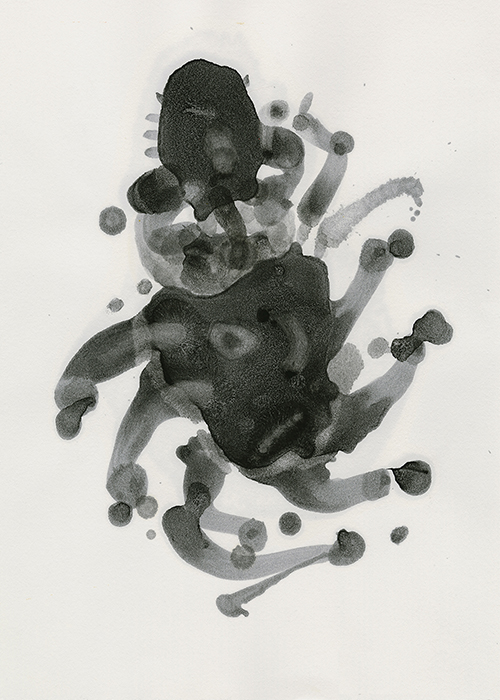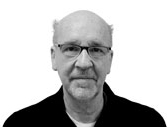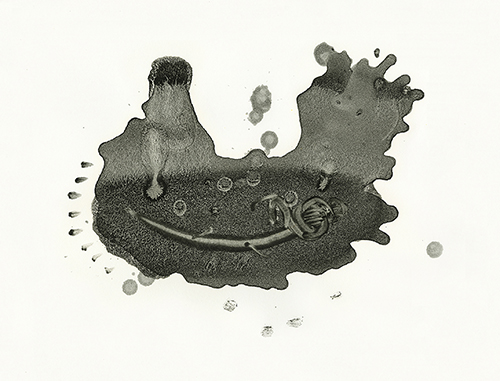
“Tusche Wash 01.07.20.” Drawn with lithographic tusche and brush on Rives BFK white paper. (IMAGE SUPPLIED BY ARTIST)

PAUL KRAINAK
Oscar Gillespie is the consummate picture maker. He’s recognized as one of the most inventive and technically fluent artists in academia, a leader in the discipline of engraving in which he’s exhibited and conducted workshops for over 30 years. One of the most physically demanding and technically complex print processes, engraving is less popular today, as traditional skills and mediums are subsumed in a regime of digital competencies.
Despite the traditional medium, Gillespie’s imagery is anything but conservative. Notwithstanding firm roots in the figurative tradition, in a craft that has exemplified classical subjects like the artists’ model and architectural illustration, he sources germane contemporary themes. He relishes exploiting both abstract and representational forms and crosses the digital boundary with ease when needed.
Gillespie is included in the historic Midwest Matrix exhibition curated by Susan J. Goldman, former Master Printer/Program Director at Pyramid Atlantic. The project documents the history of American fine art print and its influence on higher education since the end of World War II. Notable participating artists include Rudy Pozzatti, Karen Kunc, Anita Jung, James Bailey, Carmon Colangelo, and Joseph Lupo, (who studied with both Gillespie and Colangelo).
Gillespie has been the driving force in Bradley University’s 2D studio program for more than 30 years. He inherited the oversight of the Bradley Print and Drawing Biennial, as well as Cradle Oak Press, fresh from Grad School at Arizona State University in 1986. He quickly began instructing undergrads how to draw in earnest, and mentored graduate students about how to think on paper.
Thinking on paper is Gillespie’s primary method. He approaches each work meditatively, with few aids other than maybe spacetime continuum shaped by muscle memory. His drawing is essentially a meta-narrative, a biographic momentum of flourishing spaces executed with lead and burins.
Nature, in various manifestations, has been the underlying subject of his work. Birds and florae – their scale, color, texture and detail, fit his hand and are achieved with remarkable precision and formal finish. He’s blended images of wildlife with human portraits in prints and drawings with surging tactile surfaces that cannily weave representation with lyrical abstraction. Animals are generally presented as sentient, constant and esteemed while humans drift in a less serene stage of self-awareness.
Initially the practice of inscribing the image was a kind of proprietorship –– possessing and transforming an original form or site. Recently, however, Gillespie has employed more radical abstraction but with his particularized kind of mark. Now he mines his studio chronicle in the vicinity of, rather than directly, from nature. Rigorous compositions and improvised spaces are still present, but are predominately condensed in works like “TuscheWash 01.07.20,” and “TuscheWash2 11.14.17.” He takes a medium designed originally for working on a litho stone and applies it to print paper with dramatic results. “TuscheWash 01.07.20” bleeds medium on the page like dissolving microscopic cells. Sinuous contours, that Chinese brush painters would assert have “bone,” enhance the improvised stroke’s robust central density. Space and tone in both drawings contain a plausible reality that stems from decades of meticulous observation and translation. The images don’t rest on the page, but float in an auratic vapor fanned by the artist. Transcending the urge to inhabit and redefine that which exists beyond the studio, Gillespie cultivates drawing itself as the most critical of instruments and natural of subjects.

“Tusche Wash 11.14.17.” Drawn with lithographic tusche and brush on Rives BFK white paper. (IMAGE SUPPLIED BY ARTIST)

Recent Comments